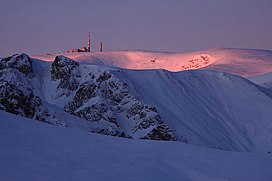Botev Peak
| Botev Peak | |
|---|---|
| връх Ботев | |
 Botev Peak | |
| Highest point | |
| Elevation | 2,376 m (7,795 ft)[1][2] |
| Prominence | 1,567 m (5,141 ft)[1] |
| Listing | Ultra |
| Coordinates | 42°43′03″N 24°55′00″E / 42.71750°N 24.91667°E[1] |
| Geography | |
| Country | Bulgaria |
| Protected area | Central Balkan National Park |
| Parent range | Balkan Mountains |
| Climbing | |
| Easiest route | a two and a half hour climb from Ray Resthouse (1,560 m) at the south foot |

Botev Peak (Bulgarian: (връх) Ботев[3] Bulgarian pronunciation: [(vrɤx) ˈbɔtɛf]) is, at 2,376 metres (7,795 ft) above sea level, the highest peak of the Balkan Mountains in southeastern Europe. It is located close to the geographic centre of Bulgaria, and is part of the Central Balkan National Park.
Until 1950, when it was renamed in honour of Bulgarian poet and revolutionary Hristo Botev, the peak was called Yumrukchal (Юмрукчал, from Ottoman Turkish Yumrukçal, 'a fist-like peak').[4]
A weather station and a radio tower (opened on 10 July 1966) that covers 65% of the country are located on Botev Peak.[5] The average temperature is −8.9 °C (16.0 °F) in January and 7.9 °C (46.2 °F) in July.[6]
"Botev Peak" is the main facility of Bulgarian FM and TV broadcasting network.[7] The situation at the top near the geographical center of Bulgaria contribute to national radio broadcasts and television broadcast here to cover more than 65% throughout the country, also in parts of Romania and Turkey.[8]
The massif is mainly composed of granite rocks dating from the oligocene — a complex of medium acid volcanics — latites, andesites, shoshonites.[9]
The flat ridge relief around Botev and Triglav is isolated with high slopes, which from the north (North Jendem) descend steeply from 2000 – 2200 m down, and from the south (South Jendem) — from 1800 – 1900 m.[10]
Channels listed by frequency
Analogue radio
| Radio programme | FM frequency | ERP | Remarks |
|---|---|---|---|
| BNR Hristo Botev | 92,20 MHz | 117.5 kW (10 kW TRP) | 1966-2003: 72.44 MHz |
| 1977-1998: 71.66 MHz (to 1992: Programme Orpheus/Znanie; to 1998: Radio Plovdiv) | |||
| BNR Horizont | 100,90 MHz | 117.5 kW (10 kW TRP) | 1966-2003: 70.88 MHz |
Digital television (since 2013)
| TV programme | Channel | ERP | Remarks |
|---|---|---|---|
| National Multiplex 2 - "Pleven" Zone (bTV, Nova, BNT 1, BNT 2, BNT HD, Bulgaria On Air) | 57 | 20 kW (3 kW TRP) | Radiation in direction North |
Analogue television (prior to 2013)
| TV programme | Channel | ERP | Remarks |
|---|---|---|---|
| BNT 1 | 11 | ~100 kW (20 kW TRP) | |
| bTV | 24 | ~100 kW (40 kW TRP) | 1975-2000: Efir 2 |
See also
References
- ^ a b c "Europe Ultra-Prominences". peaklist.org. Retrieved 2012-02-19.
- ^ "Topographic map of Botev Peak". opentopomap.org. Retrieved 2023-05-18.
- ^ "РТСС "Ботев"". Archived from the original on 2012-10-17.
- ^ "Юмрукчал". Brockhaus and Efron Encyclopedic Dictionary: In 86 Volumes (82 Volumes and 4 Additional Volumes) (in Russian). St. Petersburg: F. A. Brockhaus. 1890–1907.
- ^ РТСС "Ботев", predavatel.com
- ^ Румен Пенин, Природна география на България, стр. 170, София, 2007 г., изд. Булвест 2000
- ^ М. Георгиев, Физическа география на България, София, 1991 г., Университетско издателство СУ "Климент Охридски"
- ^ "Предавател България • Радио и телевизия от връх Ботев, Radio & Television from Botev peak". Predavatel.com. Retrieved 2014-04-18.
- ^ "Геоложка карта на МОСВ". Archived from the original on 2014-06-28. Retrieved 2021-11-13.
- ^ География на България, том 1, изд. на БАН, 1966 г.

